The Improvement of Dehydriding the Kinetics of NaMgH3 Hydride via Doping with Carbon Nanomaterials
Abstract
:1. Introduction
2. Materials and Methods
3. Results and Discussion
3.1. Structure Characterization of As-Prepared NaMgH3 Hydride and NH-CM Composites
3.2. Thermal Stabilities of NaMgH3 Hydride and NH-CM Composites
3.3. Dehydriding Kinetic Properties of NaMgH3 Hydride and NH-CM Composites
4. Conclusions
Acknowledgments
Author Contributions
Conflicts of Interest
References
- Bououdina, M.; Grant, D.; Walker, G. Review on hydrogen absorbing materials—Structure, microstructure, and thermodynamic properties. Int. J. Hydrog. Energy 2006, 31, 177–182. [Google Scholar] [CrossRef]
- Pottmaier, D.; Pinatel, E.R.; Vitillo, J.G.; Garroni, S.; Orlova, M.; Baro, M.D.; Vaughan, G.B.M.; Fichtner, M.; Lohstroh, W.; Baricco, M. Structure and thermodynamic properties of the NaMgH3 perovskite: A comprehensive study. Chem. Mater. 2011, 23, 2317–2326. [Google Scholar] [CrossRef]
- Bouhadda, Y.; Fenineche, N.; Boudouma, Y. Hydrogen storage: Lattice dynamics of orthorhombic NaMgH3. Phys. B 2011, 406, 1000–1003. [Google Scholar] [CrossRef]
- Vajeeston, P.; Ravindran, P.; Kjekshus, A.; Fjellvag, H. First-principles investigations of the MMgH3 (M = Li, Na, K, Rb, Cs) series. J. Alloy. Compd. 2008, 450, 327–337. [Google Scholar] [CrossRef]
- Bouhadda, Y.; Boudouma, Y.; Fenineche, N.; Bentabet, A. Ab initio calculations study of the electronic, optical and thermodynamic properties of NaMgH3, for hydrogen storage. J. Phys. Chem. Solids 2010, 71, 1264–1268. [Google Scholar] [CrossRef]
- Wu, H.; Zhou, W.; Udovic, T.J.; Rush, J.J.; Yildirim, T. Crystal chemistry of perovskite-type hydride NaMgH3: Implications for hydrogen storage. Chem. Mater. 2008, 20, 2335–2342. [Google Scholar] [CrossRef]
- Bouhadda, Y.; Bououdina, M.; Fenineche, N.; Boudouma, Y. Elastic properties of perovskite-type hydride NaMgH3 for hydrogen storage. Int. J. Hydrog. Energy 2013, 38, 1484–1489. [Google Scholar] [CrossRef]
- Bouamrane, A.; Laval, J.P.; Soulie, J.P.; Bastide, J.P. Structural characterization of NaMgH2F and NaMgH3. Mater. Res. Bull. 2000, 35, 545–549. [Google Scholar] [CrossRef]
- Sheppard, D.A.; Paskevicius, M.; Buckley, C.E. Thermodynamics of hydrogen desorption from NaMgH3 and its application as a solar heat storage medium. Chem. Mater. 2011, 23, 4298–4300. [Google Scholar] [CrossRef]
- Ikeda, K.; Nakamori, Y.; Orimo, S. Formation ability of the perovskite-type structure in LixNa1−xMgH3 (x = 0, 0.5 and 1.0). Acta Mater. 2005, 53, 34–53. [Google Scholar] [CrossRef]
- Martínez-Coronado, R.; Sánchez-Benítez, J.; Retuerto, M.; Fernández-Díaz, M.T.; Alonso, J.A. High-pressure synthesis of Na1−xLixMgH3 perovskite hydrides. J. Alloy. Compd. 2012, 522, 101–105. [Google Scholar] [CrossRef]
- Wang, Z.; Li, J.; Tao, S.; Deng, J.; Zhou, H.; Yao, Q. Structure, thermal analysis and dehydriding kinetic properties of Na1−xLixMgH3 hydrides. J. Alloy. Compd. 2016, 660, 402–406. [Google Scholar] [CrossRef]
- Tao, S.; Wang, Z.; Li, J.; Deng, J.; Zhou, H.; Yao, Q. Improved dehydriding properties of NaMgH3 pervoskite hydride by addition of graphitic carbon nitride. Mater. Sci. Forum 2016, 852, 502–508. [Google Scholar] [CrossRef]
- Li, Y.; Zhang, L.; Zhang, Q.; Fang, F.; Sun, D.; Li, K.; Wang, H.; Ouyang, L.; Zhu, M. In situ embedding of Mg2NiH4 and YH3 nanoparticles into bimetallic hydride NaMgH3 to inhibit phase segregation for enhanced hydrogen storage. J. Phys. Chem. C 2014, 118, 23635–23644. [Google Scholar] [CrossRef]
- Chaudhary, A.; Paskevicius, M.; Sheppard, D.A.; Buckley, C.E. Thermodynamic destabilization of MgH2 and NaMgH3 using Group IV elements Si, Ge or Sn. J. Alloy. Compd. 2015, 623, 109–116. [Google Scholar] [CrossRef]
- Webb, C.J. A review of catalyst-enhanced magnesium hydride as a hydrogen storage material. J. Phys. Chem. Solids 2014, 84, 96–106. [Google Scholar] [CrossRef]
- Bogdanović, B.; Hartwig, T.H.; Spliethoff, B. The development, testing and optimization of energy storage materials based on the MgH2-Mg system. Int. J. Hydrog. Energy 1993, 18, 575–589. [Google Scholar] [CrossRef]
- Sakintuna, B.; Lamari-Darkrim, F.; Hirscher, M. Metal hydride materials for solid hydrogen storage: A review. Int. J. Hydrog. Energy 2007, 32, 1121–1140. [Google Scholar] [CrossRef]
- Bogdanović, B.; Spliethoff, B. Active MgH2-Mg-systems for hydrogen storage. Int. J. Hydrog. Energy 1987, 12, 863–873. [Google Scholar] [CrossRef]
- Bobet, J.-L.; Akiba, E.; Nakamura, Y.; Darriet, B. Study of Mg-M (M = Co, Ni and Fe) mixture elaborated by reactive mechanical alloying—Hydrogen sorption properties. Int. J. Hydrog. Energy 2000, 25, 987–996. [Google Scholar] [CrossRef]
- Reiser, A.; Bogdanović, B.; Schlichte, K. The application of Mg-based metal-hydrides as heat energy storage systems. Int. J. Hydrog. Energy 2000, 25, 425–430. [Google Scholar] [CrossRef]
- Fakioğlu, E.; Yürüm, Y.; Veziroğlu, T.N. A review of hydrogen storage systems based on boron and its compounds. Int. J. Hydrog. Energy 2004, 29, 1371–1376. [Google Scholar] [CrossRef] [Green Version]
- Alsabawi, K.; Webb, T.A.; Gray, E.M.; Webb, C.J. The effect of C60 additive on magnesium hydride for hydrogen storage. Int. J. Hydrog. Energy 2015, 40, 10508–10515. [Google Scholar] [CrossRef]
- Imamura, H.; Takesue, Y.; Akimoto, T.; Tabata, S. Hydrogen absorbing magnesium composites prepared by mechanicalgrinding with graphite: Effects of additives on composite structures and hydriding properties. J. Alloy. Compd. 1999, 293–295, 564–568. [Google Scholar] [CrossRef]
- Imamura, H.; Tabata, S.; Shigetomi, N.; Takesue, Y.; Sakata, Y. Composites for hydrogen storage by mechanical grinding ofgraphite carbon and magnesium. J. Alloy. Compd. 2002, 330–332, 579–583. [Google Scholar] [CrossRef]
- Thiangviriya, S.; Utke, R. Improvement of dehydrogenation kinetics of 2LiBH4-MgH2 composite by doping with activated carbon nanofibers. Int. J. Hydrog. Energy 2016, 41, 2797–2806. [Google Scholar] [CrossRef]
- Kadri, A.; Jia, Y.; Chen, Z.; Yao, X. Catalytically enhanced hydrogen sorption in Mg-MgH2 by coupling vanadium-based catalyst and carbon nanotubes. Materials 2015, 8, 3491–3507. [Google Scholar] [CrossRef]
- Spassov, T.; Zlatanova, Z.; Spassova, M.; Todorova, S. Hydrogen sorption properties of ball-milled Mg-C nanocomposites. Int. J. Hydrog. Energy 2010, 35, 10396–10403. [Google Scholar] [CrossRef]
- Rud, A.D.; Lakhnik, A.M. Effect of carbon allotropes on the structure and hydrogen sorption during reactive ball-milling of Mg-C powder mixtures. Int. J. Hydrog. Energy 2012, 37, 4179–4187. [Google Scholar] [CrossRef]
- Huang, Z.G.; Guo, Z.P.; Calka, A.; Wexler, D.; Liu, H.K. Effects of carbon black, graphite and carbon nanotube additives on hydrogen storage properties of magnesium. J. Alloy. Compd. 2007, 427, 94–100. [Google Scholar] [CrossRef]
- Mandzhukova, T.; Grigorova, E.; Khristov, M.; Tsyntsarski, B. Investigation of the effect of activated carbon and 3d-metalcontaining additives on the hydrogen sorption properties of magnesium. Mater. Res. Bull. 2011, 46, 1772–1776. [Google Scholar] [CrossRef]
- Grigorova, E.; Mandzhukova, T.; Tsyntsarski, B.; Budinova, T.; Khristov, M.; Tzvetkov, P.; Petrova, B.; Petrov, N. Effect of activated carbons derived from different precursors on the hydrogen sorption properties of magnesium. Fuel Process. Technol. 2011, 92, 1963–1969. [Google Scholar] [CrossRef]
- Wu, C.Z.; Wang, P.; Yao, X.; Liu, C.; Chen, D.M.; Lu, G.Q.; Cheng, H.M. Effect of carbon/noncarbon addition on hydrogen storage behaviors of magnesium hydride. J. Alloy. Compd. 2006, 414, 259–264. [Google Scholar] [CrossRef]
- Wu, C.Z.; Wang, P.; Yao, X.; Liu, C.; Chen, D.M.; Lu, G.Q.; Cheng, H.M. Hydrogen storage properties of MgH2/SWNT composite prepared by ball milling. J. Alloy. Compd. 2006, 420, 278–282. [Google Scholar] [CrossRef]
- Skripnyuk, V.M.; Rabkin, E.; Bendersky, L.A.; Magrez, A.; Carreño-Morelli, E.; Estrin, Y. Hydrogen storage properties of as-synthesized and severely deformed magnesium multiwall carbon nanotubes composite. Int. J. Hydrog. Energy 2010, 35, 5471–5478. [Google Scholar] [CrossRef]
- Schaller, R.; Mari, D.; dos Santos, S.M.; Tkalcec, I.; Carreño-Morelli, E. Investigation of hydrogen storage in carbonnanotube-magnesium matrix composites. Mater. Sci. Eng. A 2009, 521–522, 147–150. [Google Scholar] [CrossRef]
- Singh, R.K.; Raghubanshi, H.; Pandey, S.K.; Srivastava, O.N. Effect of admixing different carbon structural variants on the decomposition and hydrogen sorption kinetics of magnesium hydride. Int. J. Hydrog. Energy 2010, 35, 4131–4137. [Google Scholar] [CrossRef]
- Ranjbar, A.; Ismail, M.; Guo, Z.P.; Yu, X.B.; Liu, H.K. Effects of CNTs on the hydrogen storage properties of MgH2 and MgH2-BCC composite. Int. J. Hydrog. Energy 2010, 35, 7821–7826. [Google Scholar] [CrossRef]
- Chen, B.-H.; Kuo, C.-H.; Ku, J.-R.; Yan, P.-S.; Huang, C.-J.; Jeng, M.-S.; Tsau, F.-H. Highly improved with hydrogen storage capacity and fast kinetics in Mg-based nanocomposites by CNTs. J. Alloy. Compd. 2013, 568, 78–83. [Google Scholar] [CrossRef]
- Ikeda, K.; Kato, S.; Shinzato, Y.; Okuda, N.; Nakamori, Y.; Kitano, A.; Yukawa, H.; Morinaga, M.; Orimo, S. Thermodynamical stability and electronic structure of aperovskite-type hydride, NaMgH3. J. Alloy. Compd. 2007, 446–447, 162–165. [Google Scholar] [CrossRef]
- RÖnnebro, E.; Noréus, D.; Kadir, K.; Reiser, A.; Bogdanovic, B. Investigation of the perovskite related structures of NaMgH3, NaMgF3 and Na3AlH6. J. Alloy. Compd. 2000, 299, 101–106. [Google Scholar] [CrossRef]
- Tao, S.; Wang, Z.; Deng, J.; Zhou, H.; Yao, Q. Improvement of dehydrogenation kinetics of NaMgH3 hydride by introducing K2TiF6 as Dopant. Int. J. Hydrog. Energy 2016, in press. [Google Scholar]
- Reardon, H.; Mazur, N.; Gregory, D.H. Facile synthesis of nanosized sodium magnesium hydride, NaMgH3. Prog. Nat. Sci. Mater. Int. 2013, 23, 343–350. [Google Scholar] [CrossRef]
- Kissinger, H.E. Reaction kinetics in differential thermal analysis. Anal. Chem. 1957, 29, 1702–1706. [Google Scholar] [CrossRef]
- Bhatnagar, A.; Pandey, S.K.; Dixit, V.; Shukla, V.; Shahi, R.R.; Shaza, M.A.; Srivastava, O. Catalytic effect of carbon nanostructures on the hydrogen storage properties of MgH2–NaAlH4 composite. Int. J. Hydrog. Energy 2014, 39, 14240–14246. [Google Scholar] [CrossRef]
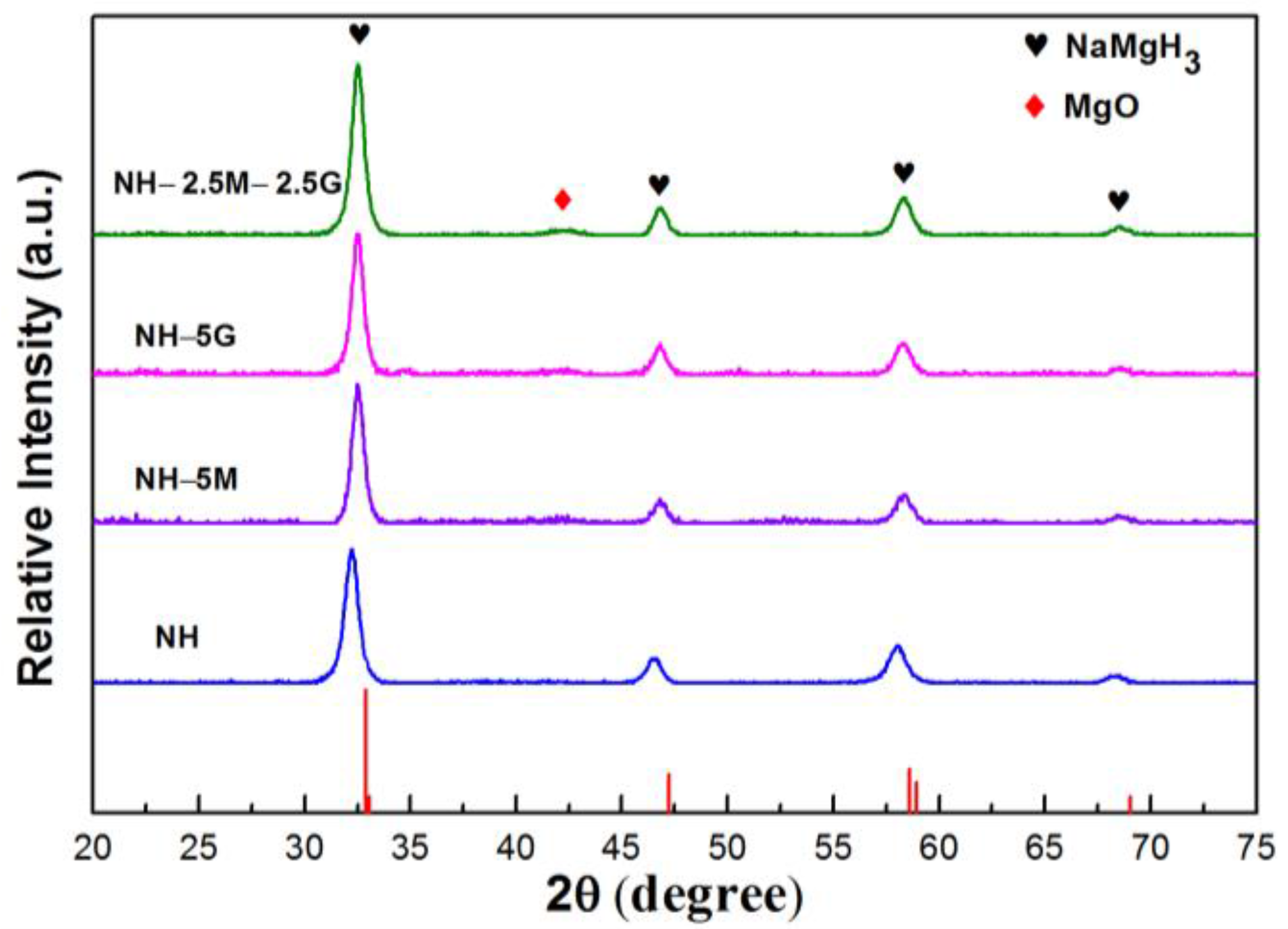
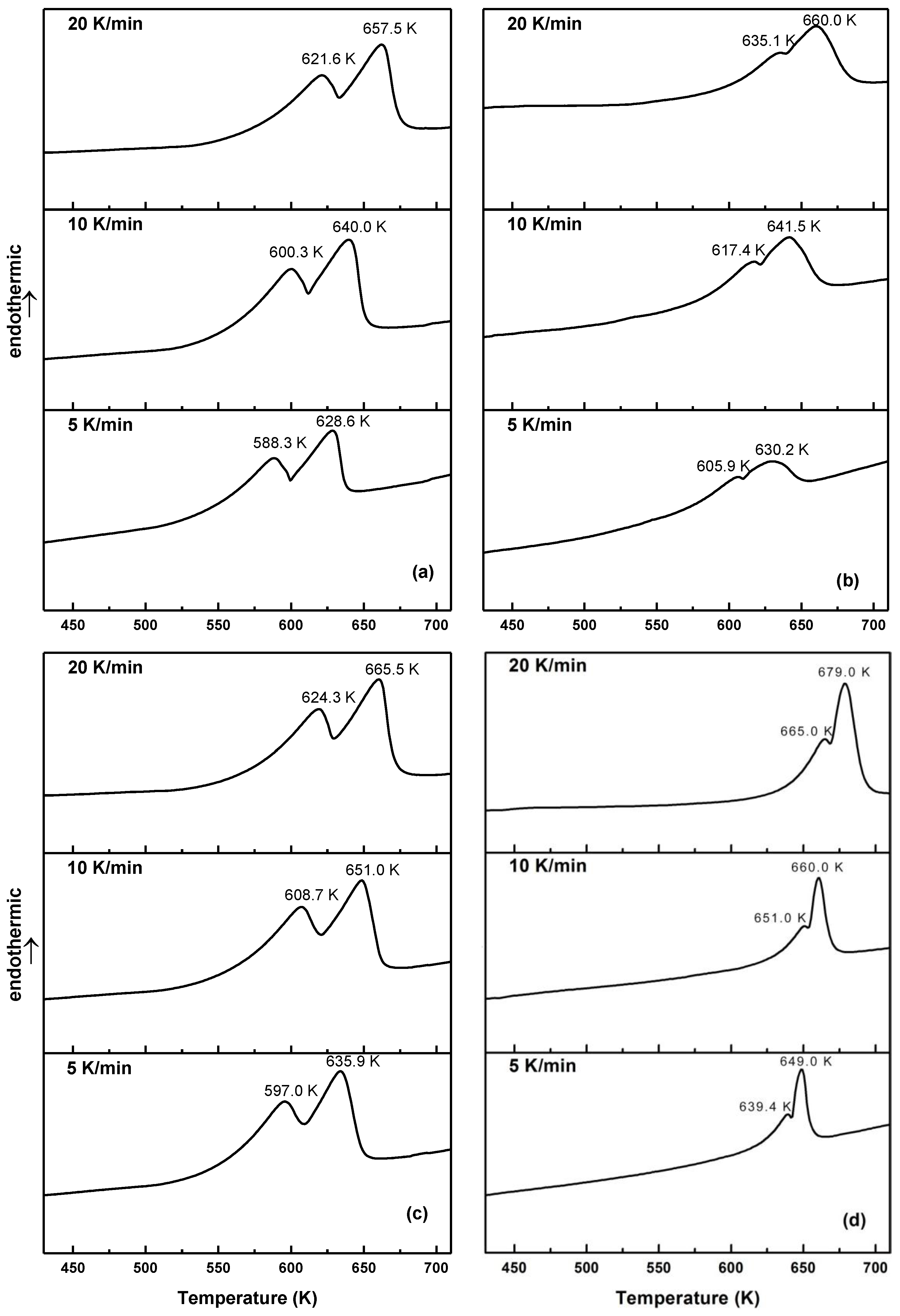
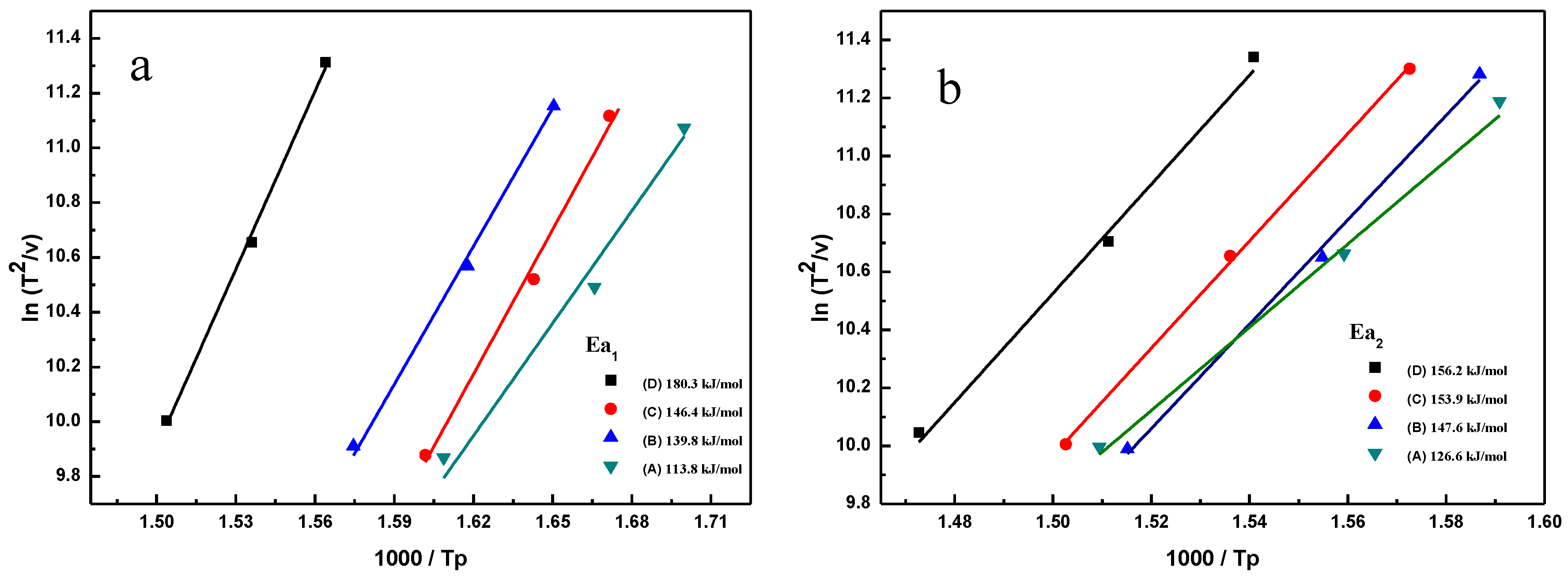
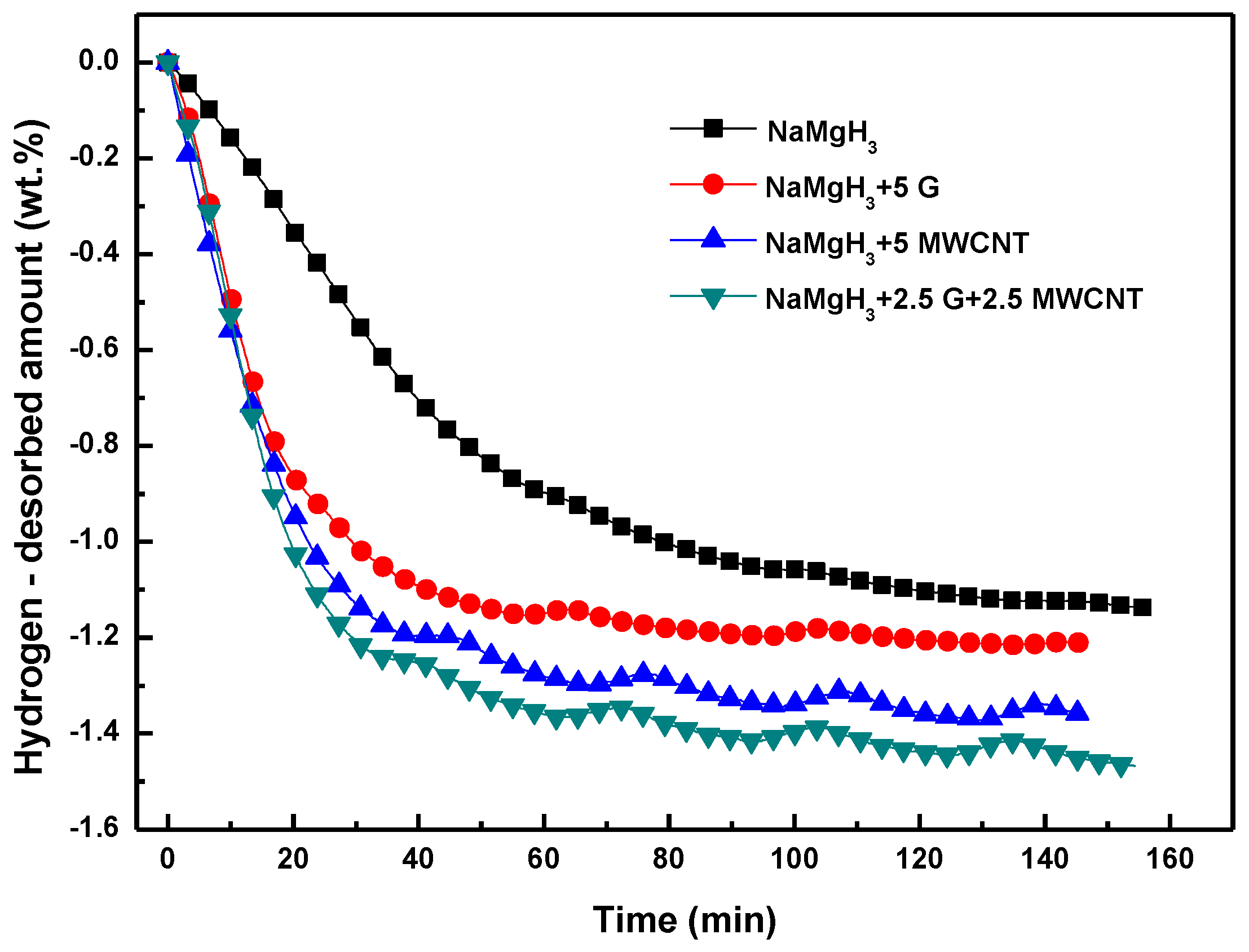
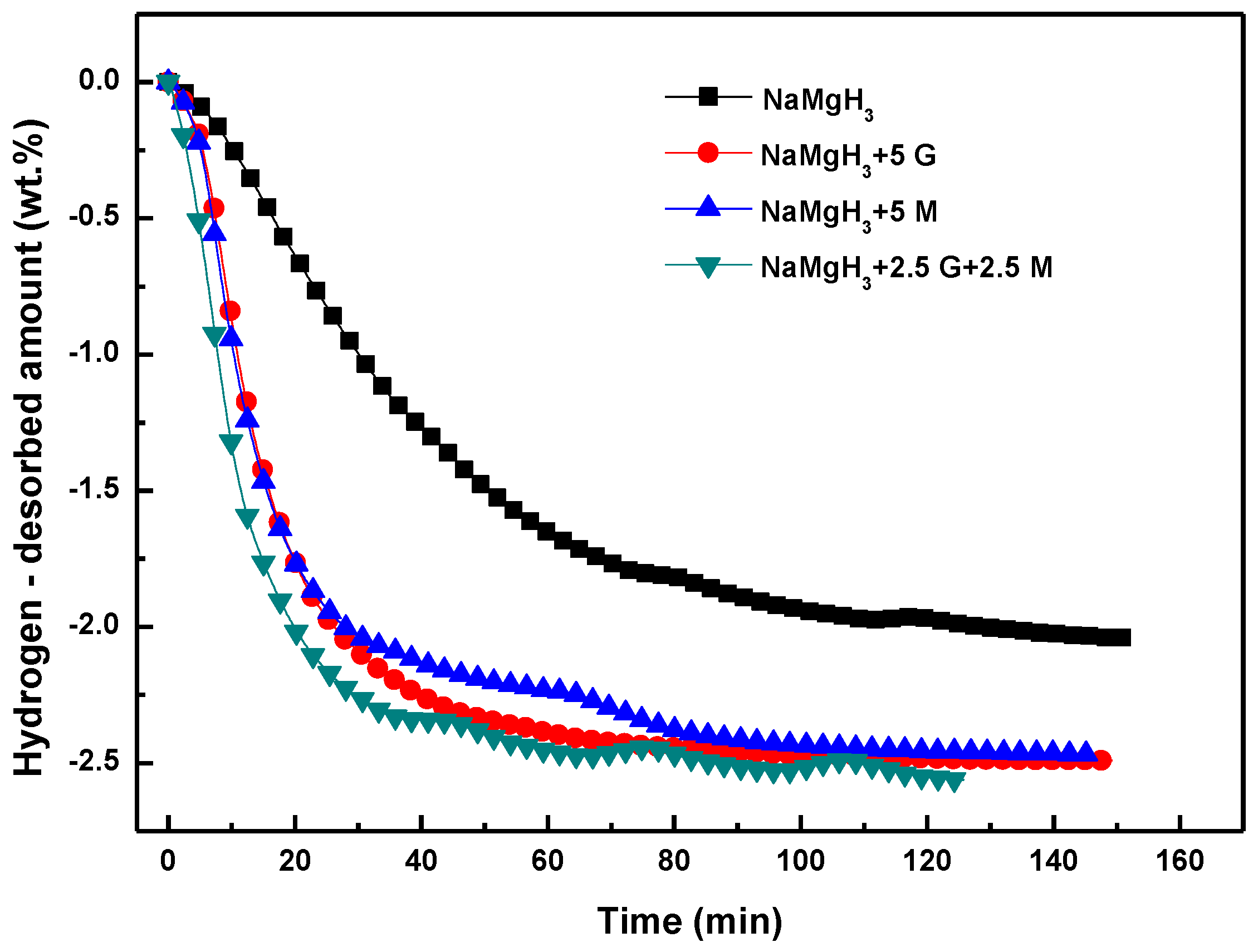
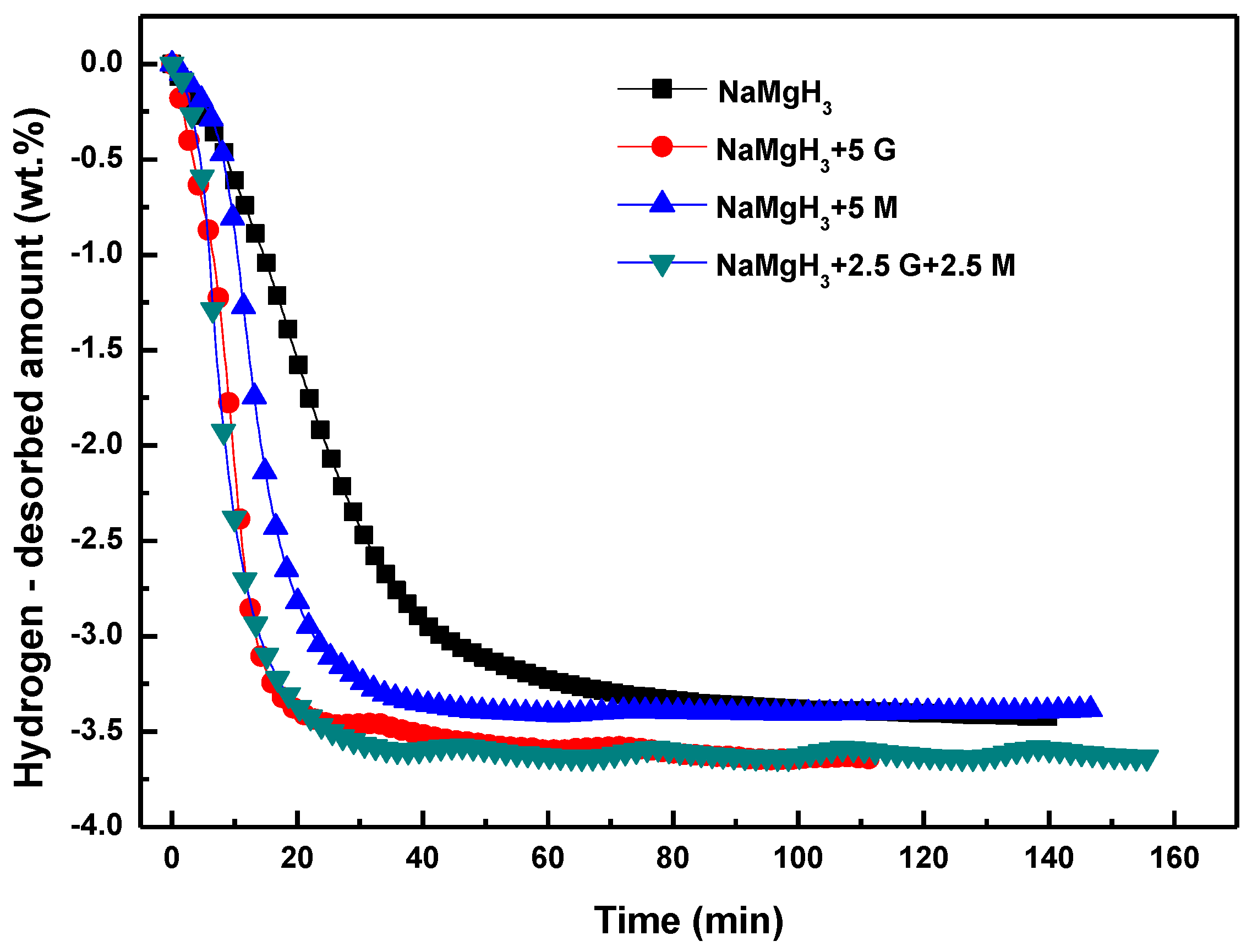
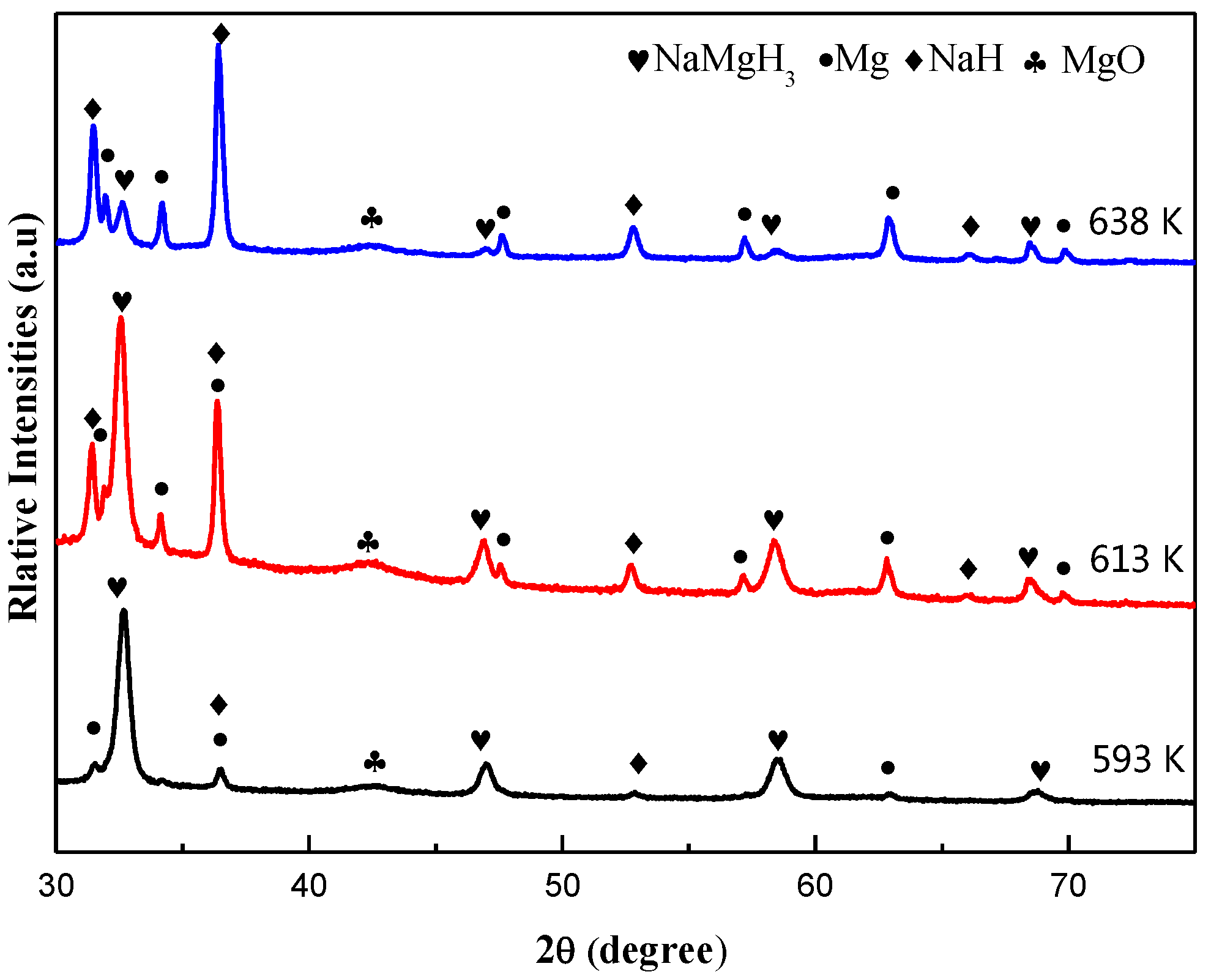
| Sample | 1st Step ΔE1 (kJ/mol) | 2nd Step ΔE2 (kJ/mol) |
|---|---|---|
| NH–2.5M–2.5G | 113.8 | 126.6 |
| NH–5G | 139.8 | 147.6 |
| NH–5M | 146.4 | 153.9 |
| NaMgH3 hydride | 180.3 | 156.2 |
| Sample/Temperature | 593 K (wt. %) | 613 K (wt. %) | 638 K (wt. %) |
|---|---|---|---|
| NaMgH3 | 1.13 | 2.03 | 3.42 |
| NH–5M | 1.36 | 2.46 | 3.40 |
| NH–5G | 1.21 | 2.49 | 3.64 |
| NH–2.5G–2.5M | 1.46 | 2.56 | 3.64 |
© 2016 by the authors; licensee MDPI, Basel, Switzerland. This article is an open access article distributed under the terms and conditions of the Creative Commons Attribution (CC-BY) license (http://creativecommons.org/licenses/by/4.0/).
Share and Cite
Wang, Z.-M.; Tao, S.; Li, J.-J.; Deng, J.-Q.; Zhou, H.; Yao, Q. The Improvement of Dehydriding the Kinetics of NaMgH3 Hydride via Doping with Carbon Nanomaterials. Metals 2017, 7, 9. https://doi.org/10.3390/met7010009
Wang Z-M, Tao S, Li J-J, Deng J-Q, Zhou H, Yao Q. The Improvement of Dehydriding the Kinetics of NaMgH3 Hydride via Doping with Carbon Nanomaterials. Metals. 2017; 7(1):9. https://doi.org/10.3390/met7010009
Chicago/Turabian StyleWang, Zhong-Min, Song Tao, Jia-Jun Li, Jian-Qiu Deng, Huaiying Zhou, and Qingrong Yao. 2017. "The Improvement of Dehydriding the Kinetics of NaMgH3 Hydride via Doping with Carbon Nanomaterials" Metals 7, no. 1: 9. https://doi.org/10.3390/met7010009





